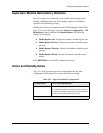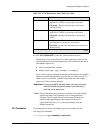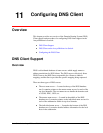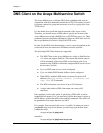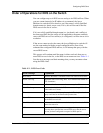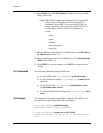
Document No. 10-300077, Issue 2 11-3
Configuring DNS Client
Sample Recursive DNS Query
Typically, a network will have a local DNS server which provides
translations for devices in the local network. That server will also “know”
the IP address of the Root servers. When a client attempts to communicate
with a device by its name, the IP portion of the protocol stack will recognize
that a name (not an address) has been specified. It will then contact the local
DNS server and request the name be translated into an IP address. For
example: if a user types
ping www.avaya.com, that name will be sent
to the local DNS server. If the DNS server has that information, it will
respond with the appropriate IP address.
If the DNS server does not have that address translation, it will contact the
root server using the IP address for that root server. In this example, it
would use the IP address for the .COM root server.
Root servers do not have specific translations for names, but they do have
the database of master name servers. The root server would the avaya.com
master name server using the avaya.com IP address.
The root server would then send a request to the master name server
requesting the translation. In small subdomains, a single DNS server may be
adequate for servicing the subdomain and be able to translate all DNS
requests. So the master name server may act as the individual name server
by providing the translations.
In large subdomains, a single DNS server may be inadequate to handle all
of the address translations. In these cases, the master name server may point
to other individual name servers. In this case, we are pinging the Web server
www.avaya.com. Assume for this example that Avaya has a single DNS
server for the entire subdomain of avaya.com. The avaya.com DNS server
would use the IP address of the Avaya Web server.
The client would then insert the IP address into the IP packets going to the
destination. In this example, it would put the IP address in the HTTP packet
going to the Avaya Web site.
The benefit of using DNS is that you need only know the name of the server
instead of the IP address for which you are trying to communicate. Also, if
the IP address of the server changes, you need only update the DNS
database.
Many vendors provide DNS servers. Consult the DNS Server vendor’s
documentation for information on configuring the DNS server. Virtually
every IP protocol stack includes DNS client capabilities. The Avaya
multiservice switch is a DNS client only.



